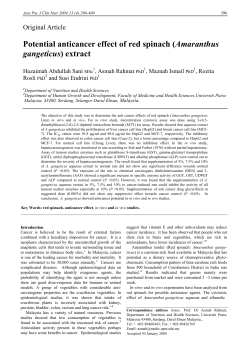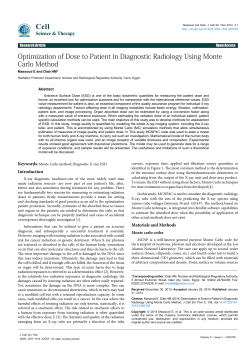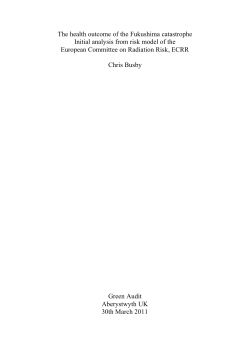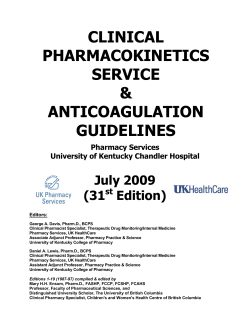
Document 2283
Slide 1 Results first presented at PAGANZ 2013, University of Queensland, Brisbane, Australia on Feb 15 2013. http://www.paganz.org/wpcontent/uploads/2013/03/PAGANZ_2013_busulfan_integrated_PK.pdf The Target Concentration Approach to Dosing in Children and Adults -Application to Busulfan Nick Holford Department of Pharmacology and Clinical Pharmacology, University of Auckland, Auckland, New Zealand Slide 2 Clinical pharmacology describes the effects of drugs in humans. One way to Clinical Pharmacology think about the scope of clinical pharmacology is to understand the factors linking dose to effect. Drug concentration is not as easily observable as doses and effects. It is believed to be the linking factor that explains the time course of effects after a drug dose. Pharmacokinetics The science linking dose and concentration is pharmacokinetics. The two Pharmacodynamics main pharmacokinetic properties of a drug are clearance (CL) and volume of distribution (V). The science linking concentration and effect is pharmacodynamics. The two CL Dose V Emax main pharmacodynamic properties of a drug are the maximum effect (Emax) EC50 Concentration and the concentration producing 50% of the maximum effect (EC50). Effect Slide 3 The target concentration approach links PKPD to prediction of the right dose for a patient. Target Concentration in Clinical Use of Medicines EC50 Emax Dose Model Initial Peak Loading Dose = Average Steady State Maintenance Dose Rate = x Volume of distribution x Clearance Ideal dose prediction requires individual estimates of Emax, EC50, Volume and Clearance Slide 4 TDM or TCI? • Therapeutic Drug Monitoring – TDM Therapeutic Range Toxic – Sub-optimal at borders of the range Ineffective Target Concentration Intervention » TCI Single Target Ideal ! » Optimal – do the best you can Slide 5 What do we need to learn? • Pharmacokinetics – Influence of body composition – Influence of young age • Dose Adjustment – AUC or Bayesian? • Target Concentration – Still just ‘best guess’ Busulfan Pharmacodynamics Note the problem of units Target Range Probability of toxicity Probability of successful transplant Slide 6 Target Range Target Range 0.6 to 0.9 mg/L; Target Concentration 0.77 mg/L Corresponds to Target AUC of 1125 umoL*min q6h dosing Bolinger AM, Zangwill AB, Slattery JT, Glidden D, DeSantes K, Heyn L, et al. An evaluation of engraftment, toxicity and busulfan concentration in children receiving bone marrow transplantation for leukemia or genetic disease. Bone Marrow Transplant. 2000;25(9):925-30. Bolinger AM, Zangwill AB, Slattery JT, Glidden D, DeSantes K, Heyn L, et al. An evaluation of engraftment, toxicity and busulfan concentration in children receiving bone marrow transplantation for leukemia or genetic disease. Bone Marrow Transplant. 2000;25(9):925-30. Slide 7 Pharmacodynamics Adults Slattery JT, Clift RA, Buckner CD, Radich J, Storer B, Bensinger WI, et al. Marrow Transplantation for Chronic Myeloid Leukemia: The Influence of Plasma Busulfan Levels on the Outcome of Transplantation. Blood. 1997;89(8):3055-60. Naïve analysis based on categorical split of concentrations around the median does not give any information about choosing the target concentration. Statistical analysis no help for identifying target Slattery et al. 1997 AUC Dose Adjustment Slide 8 from Busulfex label (PDL 2006) Slide 9 Sheiner LB, Rosenburg B, Marathe VV. Estimation of population Bayesian Dose Adjustment characteristics of pharmacokinetic parameters from routine clinical data. J Pharmacokinet Biopharm. 1977;5:445-79. Bleyzac N, Souillet G, Magron P, Janoly A, Martin P, Bertrand Y, et al. Improved clinical outcome of paediatric bone marrow recipients using a test dose and Bayesian pharmacokinetic individualization of busulfan dosage • Well established methodology for TDM based dose prediction – Sheiner 1977 – Applied to busulfan paedatric BMT (Bleyzac 2001, Salinger 2010) • Flexible – Not affected by sampling times (provided they are accurate) – First dose can be loading dose > maintenance dose • Output – Estimate of patient’s clearance (CL) and dose – Any dosing interval (e.g. q6h, daily, continuous infusion) Dose mg q interval h 265 mg q 24 h = TargetConc (mg/L) * CL (L/h) = 0.770 mg/L * 14.3 L/h * interval (h) * 24 h regimens. Bone Marrow Transplant. 2001;28(8):743-51. Slide AUC vs Bayesian Dose Adjustment 10 Method Sampling Times (h) AUC lin 2,4,6 -2.3% 0.8 AUC lin 2.5,4,6 8.2% 0.6 AUC lin/log 2,4,6 2.5% AUC lin/log 2.5,4,6 13.2% Bayesian 2,4,6 0.3% Bayesian 2.5,4,6 0.3% 1.4 1.2 mg/L 1 0.4 0.2 0 0 • • • 1 2 3 4 Time (hours) 5 6 Dose Error Simulated concentrations without error AUC linear or linear/log trapezoidal Bayesian pharmacokinetic model AUC method sensitive to sampling time but Bayesian PK is not Slide Presented at PAGANZ 2013, University of Queensland, Brisbane, Australia 11 on Feb 15 2013. http://www.paganz.org/wp- Busulfan in infants to adult hematopoietic cell transplant recipients: A population pharmacokinetic model for initial and Bayesian dose personalization Jeannine S. McCune1,3, Meagan J. Bemer1, Jeffrey S. Barrett4, K. Scott Baker2, 3, 5, Alan S. Gamis6, Nicholas H.G. Holford7 University of Washington Schools of 1Pharmacy and 2Medicine, Seattle, WA; 3Fred Hutchinson Cancer Research Center, Seattle, WA; 4Division of Clinical Pharmacology & Therapeutics, The Children's Hospital of Philadelphia, Philadelphia, PA; 5Seattle Children’s Hospital, Seattle, WA; Mercy Hospitals and Clinics, Kansas City, MO; 7University of Auckland Department of Pharmacology and Clinical Pharmacology, Auckland, New Zealand. 6Children’s Slide The Data 12 • Routinely collected busulfan concentration profiles were obtained at a national center for measuring busulfan concentrations • Dosing and demographic data was matched with 12,182 concentrations in 1610 patients • 92% of patients were under the age of 20 Handful of Concs before end of infusion content/uploads/2013/03/PAGANZ_2013_busulfan_integrated_PK.pdf Slide Pharmacokinetic and Random Effect Models 13 Zero order input using dose and input duration recorded by clinical staff Two compartment distribution First order elimination • • • • Between subject and within subject variability estimated with exponential model for random effect Combined additive and proportional residual error • NONMEM 7.2 FOCE Interaction • Slide It is hoped that future studies of busulfan will record actual weight and use The Weight Problem 14 • Clinical tradition has been to record ‘dosing weight’ (DWT) which is then used to predict the dose on a mg/kg basis • There are many ‘dosing weight’ formulas but the formula was not recorded and actual body weight was not known • 133 patients (108 adults and 25 children) had actual body weight (AWT) recorded Slide 15 actual weight to predict doses using normal fat mass (see below). No systematic difference between TBW and DWT was found in males. A Solution... TBWi =DWT × FFEM DW × exp(η DW ) TBW=Total body weight prediction DWT=Dosing weight covariate FFEMDW=Factor in women relative to men that predicts TBW Females had a slightly higher TBW. Slide Details of calculation of body size and maturation can be found in Holford N Size and Maturation 16 • 2010. Dosing in children. Clin Pharmacol Ther 87(3):367-370. Body Size – Fat mass was accounted for by using total body weight and fat free mass to predict normal fat mass NFM=FFM + Ffat*(TBW – FFM) – Theory based allometry was used to determine the best body size metric • Maturation – Maturation of clearance was described using a sigmoid Emax maturation model Fmat = 1 PMA 1+ TM 50 − Hill CLPREDICTEDNFM ,PMA = CLNFM ⋅ Fmat TM50=PMA at 50% maturation Slide 17 The VPC shows excellent predictions of observed concentrations except Model Evaluation samples taken before the end of the (usually) 2 hour infusion. It is probable that these samples were contaminated because there were drawn from the Handful of Concs before end of infusion Slide 18 same catheter used to infuse busulfan without adequate flushing. The two main covariates, weight and age, show no residual mis-specification Covariate Evaluation Weight Age of the model. The higher concentrations in adults reflect the use of daily rather than 6 h dosing with samples drawn mainly in the first 6 hours after the dose. Slide Both clearance and volume were better related to normal fat mass than either Structural Parameters 19 predicted total body weight or fat free mass. Maturation of busulfan clearance reaches 50% of the predicted size standardized adult value around 6 weeks after full term (40 weeks) gestation. There is a slightly larger steady state volume of distribution in females. Parameter Description Units CL Clearance V1 Central volume of distribution Q Inter-compartmental clearance V2 Peripheral volume of distribution L/h/70kg FFATV Fat fraction for clearance (from ABW data) Fat fraction for volume (from ABW data) TM50CL PMA at 50% maturation HILLCL Hill coefficient for maturation FFEMV Fractional difference in total volume (V1+V2) in females FFEMDW Fractional difference in dosing weight in females FFATCL Bootstrap Estimate L/70kg L/h/70kg L/70kg 12.5 15.8 148.1 33.9 1.1% 12.2 12.7 6.6% 13.5 17.9 7.2% 126.4 168.0 3.0% 32.1 35.8 42.8% 0.110 0.950 51.6% 0.016 0.429 4.3% 41.6 49.2 2.3 9.7% 1.93 2.74 1.07 1.2% 1.05 1.10 1.08 1.7% 1.05 1.11 . 0.509 . 0.203 45.7 weeks . Bootstrap 97.5% 2.5% ile RSE ile Predicted total body weight also tended to be slightly larger than dosing weight in females. Weights are Normal Fat Mass for CL and V Slide Wide range (95% interval) of weight (5-90 kg) and large sample size Test of Allometric Theory 20 (N=1610) provides a design suitable for testing the predictions of theory based allometry. The 95% confidence interval of the estimate of the exponent for clearance is narrow and includes the theoretical value of ¾. Similar agreement between theory and observation is seen for V1 and V2 (theoretical • Wide range (95% interval) of weight (5-90 kg) and large sample size (N=1610) value of 1). It is uncertain if intercompartmental clearance is more like • Allometric exponents estimated with starting value of 0.67 for CL and Q and 1.25 for V1 and V2 relatively wide and includes both ¾ and 1. There is no support for an • Non-parametric bootstrap used to estimate average and 95% confidence interval for allometric exponents surface area was an appropriate size metric. Bootstrap Bootstrap Estimate RSE Parameter Description PWR_CL PWR_V1 PWR_Q PWR_V2 Allometric exponent for CL Allometric exponent for V1 Allometric exponent for Q Allometric exponent for V2 0.767 1.059 0.845 0.993 3.1% 9.1% 11.8% 4.0% 2.5% ile 0.724 0.932 0.695 0.888 elimination clearance or volume of distribution. The confidence interval is allometric exponent of 2/3 for clearance which would be expected if body 97.5% ile 0.817 1.321 1.065 1.060 Slide The maturation of size standardized clearance shows about a 2 fold range Prediction of Maturation 21 from neonates to adults. There is clearly substantial unexplained between and within subject variability even after accounting for age and weight. The unpredictable, apparently random, between subject variability can be reduced by using target concentration intervention to improve individual estimates of clearance. This in turn can be used to predict the busulfan dosing regimen to achieve the target concentration. Clearance L/h/70kg NFM 30 25 20 15 10 5 0 0.0625 0.25 1 4 Post Natal Age year 16 64 Slide The integrated model developed from PK data from children and adults was Prediction of Initial Covariate Guided Doses 22 600 used to obtain a Bayesian estimate of clearance for each patient. This estimate of clearance was used to make the best guess estimate of the daily dose required to reach a target steady state concentration of 0.77 mg/L. Initial dose predictions were made using just covariate based models for clearance according to the current integrated study and those reported in the literature (Bartelink 2012, Paci 2012, Trame 2011). In general all methods gave reasonable predictions of the required daily dose 500 Initial mg q 24h except when the non-integrated methods were applied in children (best guess 400 Age and Size doses less than 150 mg/day). There was one instance where the integrated Bartelink model initial dose was just over twice as big as the required daily dose. Paci 300 200 100 Trame Bartelink IH, Boelens JJ, Bredius RGM, Egberts ACG, Wang C, Bierings MB, FDA Shaw PJ, Nath CE, Hempel G, Zwaveling J, Danhof M, Knibbe CAJ 2012. EMA Body Weight-Dependent Pharmacokinetics of Busulfan in Paediatric Identity Haematopoietic Stem Cell Transplantation Patients: Towards Individualized Dosing. Clin Pharmacokinet 51(5):331-345. 0 0 100 200 300 400 Age and Size Bayesian mg q24h 500 Paci A, Vassal G, Moshous D, Dalle JH, Bleyzac N, Neven B, Galambrun C, 600 Kemmel V, Abdi ZD, Broutin S, Petain A, Nguyen L 2012. Pharmacokinetic behavior and appraisal of intravenous busulfan dosing in infants and older children: the results of a population pharmacokinetic study from a large pediatric cohort undergoing hematopoietic stem-cell transplantation. Ther Drug Monit 34(2):198-208. Trame MN, Bergstrand M, Karlsson MO, Boos J, Hempel G 2011. Population pharmacokinetics of busulfan in children: increased evidence for body surface area and allometric body weight dosing of busulfan in children. Clin Cancer Res 17(21):6867-6877. Slide Initial Dosing Methods 23 Acceptable if within 80-125% of individual Bayesian predicted dose Age & Size method overall better than EMA method. FDA and other published methods markedly inferior. Age Group All Ages Method Acceptable Age & Size 72% EMA 70% FDA 57% Bartelink 66% Paci 66% Trame 66% Age Group Age>=1 and <2 Method Acceptable Age & Size 69% EMA 72% FDA 54% Bartelink 60% Paci 60% Trame 60% Age Group Age>=5 and <10 Method Acceptable Age & Size 78% EMA 71% FDA 49% Bartelink 70% Paci 69% Trame 69% Age Group Age<1 Method Acceptable Age & Size 62% EMA 61% FDA 54% Bartelink 56% Paci 56% Trame 56% Slide FirstDose and AUC nh926.xls Busulfan FirstDose 24 Excel Based Calculator for Children and Adults Slide But … 25 • At best only 2/3 of patients will get a suitable busulfan dose • So 1/3 of patients will be either overtreated or undertreated • What can we do for them? Slide 26 Safe and Effective Variability • CLINICAL JUDGMENT Suppose medicine use is safe and effective if: 1. Individual Css is on average at the Target Conc 2. • • Aim for the optimum target 90% of the time Css is within 80%-125% of Target Conc • ‘therapeutic range’ with optimum target STATISTICS Assume log-normal distribution for Css 90% of Css must lie within 1.64 x SD • Therefore SD must be 0.136 The Safe and Effective Variability (SEV) is 13.6% Slide Three Ways to Dose 27 Population • – Same dose for everyone • The dream dosing method! Group (Covariate guided) • – Same dose for similar group • e.g. same weight, CLcr, genotype Individual • – Dose determined by individual response • e.g. BP, INR, blood conc Slide 28 Dosing Individualization Method Depends on Safe and Effective Variability (SEV) Suppose total variability PPVtotal=0.7, unexplained BSVu=0.4, unexplained WSVu=0.3 Unexplaiined PPVU=sqrt(BSVu2 + WSVu2)=0.5 Predictable BSVP=sqrt(PPVtotal2 – BSVu2)=0.57 SEV Method Criterion Example Dosing Strategy 0.9 SEV>PPVtotal 0.9>0.7 Population dosing 0.55 PPVtotal > SEV SEV>PPVu 0.35 PPVu > SEV SEV>WSVu 0.7>0.55 0.55>0.5 0.5>0.35 0.35>0.3 Group dosing (WT, CLcr, etc) (BSVP 0) Individual response dosing (TCI) (BSVU 0) Holford NHG, Buclin TMD. Safe and effective variability - A criterion for dose individualization. Ther Drug Monit 2012; 34: 565-68 Slide The between occasion variability in clearance is an estimate of the irreducible Key Busulfan Random Effect Parameters 29 Parameter Description BSVu CL Unexplained BSV in clearance WSVu CL Unexplained WSV in clearance RUVADD Additive RUV (ng/mL) RUVPROP Proportional RUV Bootstrap Bootstrap Estimate RSE 2.5% ile within subject variation in clearance from which cannot be improved by target concentration intervention. 97.5% ile 0.215 0.113 4.7% 0.195 0.234 14.8% 0.081 0.145 26.2 13.7% 18.9 32.8 0.0387 12.8% 0.0298 0.0468 BSVtotal (predictable plus unpredictable BSV)=0.33 BSVp (predictable BSV)=0.22 (55% of total BSV variability) BSV = Between subject variability (sqrt(OMEGA)) WSV = Within subject variability (sqrt(OMEGA)) RUV= Residual unidentified variability (sqrt(SIGMA)) Slide Safe and Effective Variability (SEV) Busulfan 30 PPVU BSVU 0.24 0.22 Matthews I, Kirkpatrick C, Holford NHG. Quantitative justification for target concentration intervention - Parameter variability and predictive performance using population pharmacokinetic models for aminoglycosides. British Journal of Clinical Pharmacology 2004;58(1):8-19 WSVU 0.113 ∴ • Suggested Therapeutic Success Criterion 95% of Concs Within 80%-125% of Target Css SEV is 0.114 (log normal SD) ∴ • Unpredictable PPVU is 0.24 and is >> SEV Covariate (WT, Age) prediction alone will be inadequate • Unpredictable WSVU is 0.113 and is < SEV (just!) TCI can achieve safe and effective target ∴ ∴ Slide 31 Holford NHG, Buclin TMD. Safe and effective variability - A criterion for dose Why TCI is Necessary • The acceptable exposure range we propose for busulfan is based on a goal of 95% of patients lying within 80125% of the target Css. • With TCI the unpredictable variability for busulfan can be reduced to the WSV of CL 11.3%. • This means that only 5% of patients will be under- or over-dosed. A major improvement over initial dosing based on size and age. Slide 32 Conclusion • Theory based allometry confirmed experimentally for CL, V1, (Q) and V2 • Normal fat mass describes allometric size better than other methods • Maturation of busulfan clearance reaches half of adult values around 6 weeks after full term delivery • TCI is essential to achieve exposure goals in 95% of treated patients individualization. Ther Drug Monit. 2012;34(5):565-8. Slide Practical Questions 33 • Number and timing of blood samples for busulfan measurement? • Should doses be adjusted to achieve – target AUC ignoring whether first dose was too or too low? – The traditional goal or – total treatment period target AUC? – The pharmacological theory goal Slide 34 Slide 35 The percentile are derived from the empirical distribution of baseline values Demographics for these demographic features. Note that ideal body weight (IBW) is frequently negative in children because the empirical IBW formula was developed in adults and is not appropriate for children. Statistic Units average 2.5% ile 97.5% ile PNA year 9.8 0.3 58.4 PMAW week 551 56 3089 AWT kg 30.8 5.2 89.7 DWT kg 30.2 5.2 84.4 FFMKG kg 23.3 4.3 64.5 HTCM cm 116 58 181 BMI kg/m^2 18.9 12.6 30.8 IBW kg 14.9 -38.3 76.1 Slide Busulfan Random Effect Parameters 36 The between occasion variability in clearance is an estimate of the irreducible within subject variation in clearance from which cannot be improved by target concentration intervention. BSVtotal (predictable plus unpredictable BSV)=0.33; BSVp=0.22 (55% of total BSV variability) Bootstrap Bootstrap Estimate RSE Parameter Description FDW BSV in Fraction of Dosing Weight CL BSV in clearance V1 BSV in central volume Q V2 BSV in intercompartmental clearance BSV in peripheral volume CL V1 Q V2 RUVADD RUVPROP Proportional RUV 2.5% ile 97.5% ile BOV in clearance 0.166 0.215 0.410 0.922 0.120 0.113 7.8% 4.7% 10.8% 9.1% 23.8% 14.8% 0.134 0.195 0.329 0.730 0.059 0.081 0.185 0.234 0.506 1.059 0.183 0.145 BOV in central volume BOV in intercompartmental clearance BOV in peripheral volume Additive RUV (mcg/L) 0.244 0.577 0.212 26.2 20.0% 24.6% 12.4% 13.7% 0.147 0.330 0.162 18.9 0.327 0.903 0.264 32.8 0.0387 12.8% 0.0298 0.0468 BSV = Between subject variability (sqrt(OMEGA)) BSV = Between occasion variability (sqrt(OMEGA)) RUV= Residual unidentified variability (sqrt(SIGMA)) Slide Published Busulfan PK Parameters 37 Clearance Estimate 12.2 10.3 12.6 10.6 12.4 Units L/h/70kg L/h/70kg L/h/70kg L/h/70kg L/h/70kg Estimate 44.8 50.6 Not done Not done Units L/70kg L/70kg Slide Population 173 adults oral (normal weight) 24 children IV (allometric) 37 adults IV (daily doses) 44 adults; 13 <18y IV 94 adults; 1 < 18y oral Volume Population 24 children IV 37 adults IV 44 adults; 13 <18y IV 94 adults; 1 < 18y oral Source Gibbs 1999 Booth 2006 Salinger 2010 Abbasi 2011, PDL 2006 Abbasi 2011 Source Booth 2006 Salinger 2010 Abbasi 2011 Abbasi 2011 Published Busulfan PK Variability 38 Clearance BSV+BOV BSV BOV BSV+BOV 25% 23% 10% 20% Limiting factor for dose prediction BSV+BOV BSV BOV BSV+BOV Population 24 children IV (allometric) Source Booth 2006 94 adults; 1 < 18y oral Salinger 2010 Volume 12% 11% 6% 16% Population 24 children IV (allometric) Source Booth 2006 94 adults; 1 < 18y oral Salinger 2010 BSV=Between Subject Variability BOV=Between Occasion Variability
© Copyright 2025





















